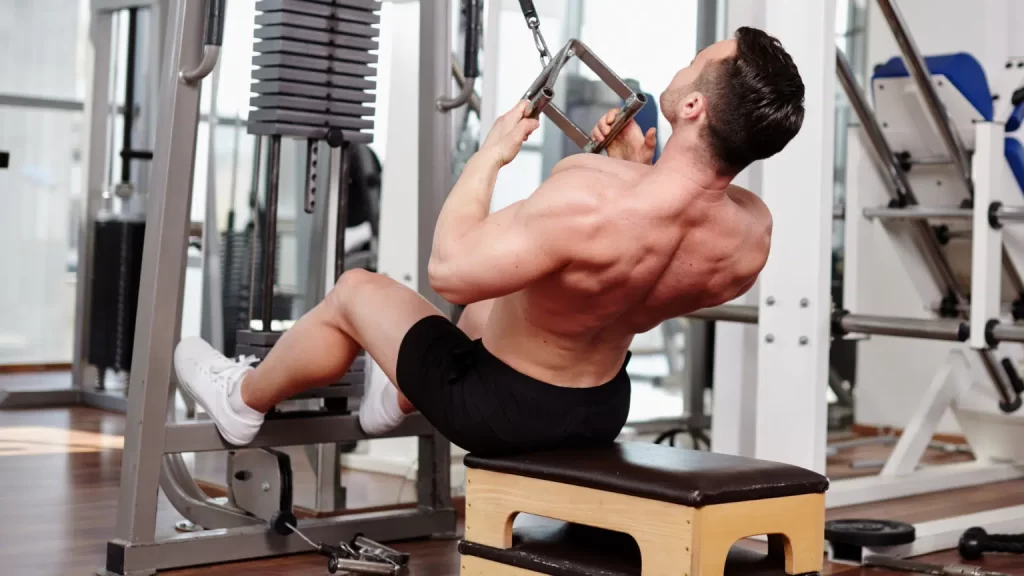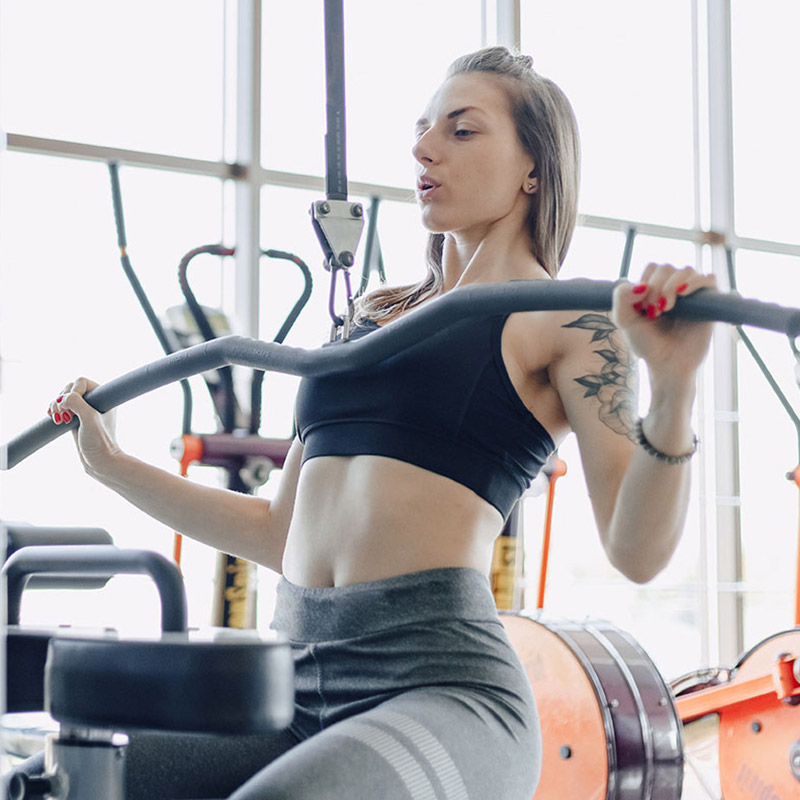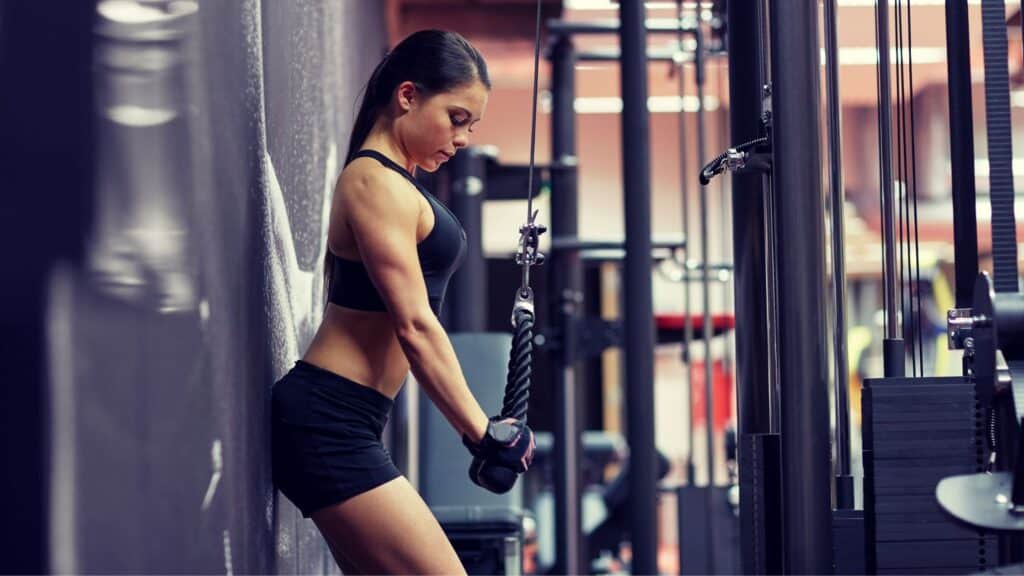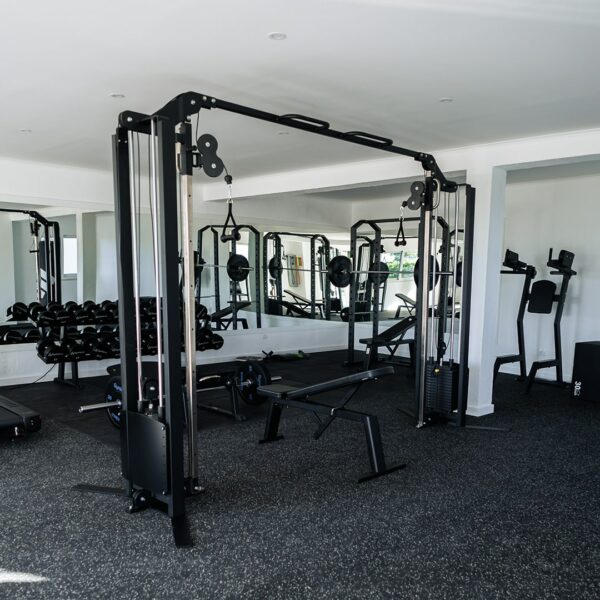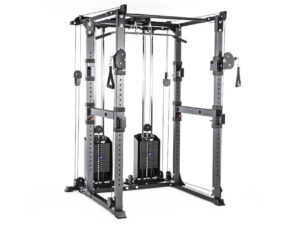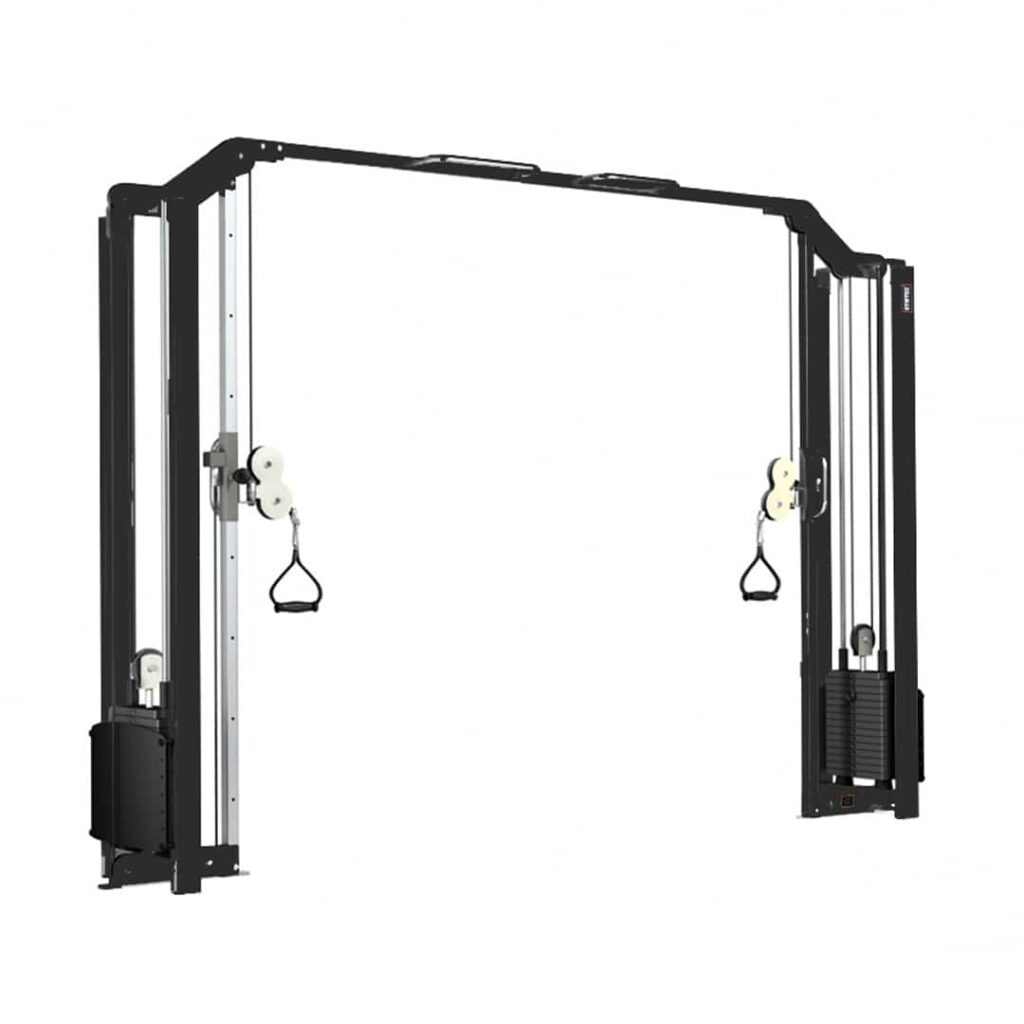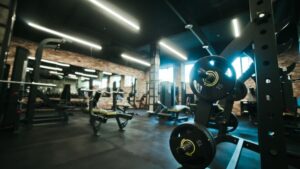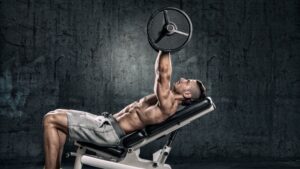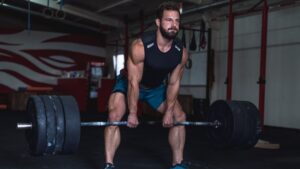Yes, cable machines can look like a jungle of handles, pulleys, and weight stacks when you first walk up to one. But once you get the hang of it, it’s actually one of the easiest and most flexible pieces of gym equipment you’ll ever use. Whether you’re just starting your fitness journey or you’ve been training for years, cable machines let you move naturally, adjust quickly, and work every part of your body without needing a full rack of weights.
We love them because they make workouts smoother, safer, and more creative. You don’t need to lift the heaviest weight to feel the challenge, just the right angle, some steady resistance, and good form can go a long way.
In this article, we’ll focus on how cable machines really work, why they’re so effective, and how you can get the most out of every rep.
What is a Cable Machine?
A cable machine is an essential type of strength-training equipment that incorporates a system of pulleys, cables, and adjustable weights to provide a dynamic exercise environment. Unlike free weights, where resistance is solely dependent on gravity, cable machines create resistance through the tension of cables, allowing movement in multiple angles and planes.
This design helps users perform a wide array of exercises without the need to frequently switch equipment, optimizing both time and space in fitness routines. The adjustable nature of cable machines, from height and angle to attachments, enables the isolation of targeted muscle groups and caters to diverse fitness levels.
Modern cable machines are often equipped with either single or dual weight stacks, and their cable arms allow for both bilateral and unilateral movements, offering more exercise variety. Additionally, these machines may feature different pulley ratios, such as 1:1 or 2:1, affecting the weight’s feel during lifts, and specialty attachments can be swapped to target specific muscle groups or vary grips, enhancing the training experience.
Why Should You Use a Cable Machine?
The primary benefit of using a cable machine is the constant tension it provides throughout each exercise, which significantly increases muscle engagement and promotes strength gains. This continuous tension ensures that your muscles are effectively worked through every phase of the exercise, enhancing the efficiency of your workout.
Another key advantage is the improvement in core stability. Many exercises on a cable machine are performed standing and require you to maintain balance, which naturally engages and strengthens the core muscles. This aspect of cable workouts is crucial for overall fitness and injury prevention, as a strong core supports better posture and reduces the risk of falls and related injuries.
Safety is a paramount concern in any workout routine, and cable machines excel in this area. The risk of dropping heavy weights is virtually eliminated, and the guided path of the cables helps users maintain better form, reducing the likelihood of injury. This makes cable machines particularly ideal for beginners who are still learning proper movement patterns, as well as for advanced trainees focused on isolating and intensifying work on specific muscle groups.
Cable machines are also designed with labeled weight stacks that simplify the process of tracking progressive overload—critical for continuous improvement in strength training. Beginners find that exercises on cable machines are easier to learn compared to barbell movements due to the guided range of motion provided by the pulleys.
What are the Benefits of Cable Machines Over Free Weights?
One of the foremost benefits of cable machines over free weights is the ability to alter the angle of pull. This versatility allows for targeting muscles in ways that barbells and dumbbells cannot, offering a broader range of motion and the ability to focus on specific muscle groups with precision.
The cable system maintains a consistent load on the muscle throughout the entire range of an exercise, eliminating any resting points and maximizing muscle tension and growth potential.
Adjustable pulley settings are another significant advantage, as they enable customized movement paths that can accommodate individual limitations or injuries. This adaptability helps reduce joint strain and is particularly beneficial for individuals recovering from injuries or those with chronic joint issues, allowing them to exercise without exacerbating their conditions.
Furthermore, the built-in stability of cable machines facilitates more controlled movements. This control is crucial when learning new exercises or when focusing on rehabilitation. The stable setup of cable machines minimizes the likelihood of sudden weight drops, enhancing safety during workouts.
Can Cable Machines Replace Free Weights?
When considering whether cable machines can replace free weights, it’s essential to understand the unique benefits each type of equipment offers. Cable machines provide a variety of attachments and deliver consistent tension throughout exercises, making them a versatile and safe option. They allow users to perform a wide range of movements that can mimic many free-weight exercises, adapting easily to different strength levels and training goals.
However, free weights offer distinct advantages, particularly in terms of engaging stabilizer muscles and allowing for natural movement paths. Exercises with free weights tend to involve more compound movements that can improve functional strength and coordination more effectively than some cable machine exercises. This is because free weights require the lifter to control the path of the weight entirely, engaging more muscle groups simultaneously.
Many fitness programs incorporate both cable machines and free weights to provide a comprehensive strength training experience. Cable machines excel in providing safety and controlled movements, making them ideal for beginners or those recovering from injuries.
They are also superb for isolating specific muscle groups and achieving precise tension throughout exercises. On the other hand, free weights challenge lifters to maintain balance and stability, which can lead to significant strength gains and improvements in muscular coordination.
Ultimately, the choice between cable machines and free weights depends on your personal fitness goals, available space, and preferences. Some individuals may prefer the simplicity and challenge of free weights, while others may opt for the adaptability and safety of cable machines.
Which Muscle Groups are Targeted by Cable Machines?
By adjusting the height, angle, and attachments, these machines allow for a comprehensive workout that includes the upper body, lower body, and core. Upper-body exercises commonly performed on cable machines include rows, chest presses, shoulder presses, biceps curls, and triceps extensions. These exercises ensure that the tension remains constant on the targeted muscles, enhancing the effectiveness of each movement.
For the lower body, cable machines facilitate exercises like squats, lunges, and various glute-focused movements, particularly when the attachments are adjusted to lower positions.
This versatility not only helps in sculpting muscle but also in enhancing functional strength and stability. The importance of maintaining correct form cannot be overstated, as it is crucial to engage the stabilizers around the shoulders, hips, and spine effectively.
Additionally, adjusting the pulley’s height allows users to focus on different areas within the same muscle group, adding variety to the workout routine. For example, transitioning from a high-to-low cable fly to a low-to-high cable fly changes the emphasis within the chest muscles, making the workout more comprehensive.
Standing exercises on the cable machine recruit core and lower back stabilizers more effectively than seated exercises, providing an added benefit of enhancing core strength and stability throughout the workout.
Upper Body Muscles
Cable machines provide a dynamic platform for targeting various upper body muscles. Exercises such as cable chest fly, chest press, seated or standing row, shoulder press, lateral raises, biceps curls, and triceps pushdowns are particularly effective. These exercises maintain constant tension on the muscles like the chest, shoulders, back, biceps, and triceps, which is vital for developing the mind-muscle connection—a key aspect of successful strength training.
Controlling the eccentric (lowering) phase of each repetition is another benefit, as it helps to build additional strength, especially in the chest and back muscles. Specific exercises like cable tricep pushdowns and tricep dips focus intensely on the triceps without significant shoulder involvement, allowing for targeted muscle development. Similarly, a standing cable chest fly not only works the pectoral muscles but also engages the core significantly more than a seated press, enhancing overall body balance and functional fitness.
Lower Body Muscles
Cable machines offer an effective way to target the entire lower body, engaging muscle groups such as the quadriceps, hamstrings, glutes, and calves. Exercises like cable squats, cable lunges, and kickbacks provide dynamic resistance that challenges these muscles, enhancing both strength and stability. Cable squats, for instance, offer a safer alternative to traditional squats as they eliminate the risk associated with heavy bars on the back while still providing robust resistance necessary for muscle growth and endurance.
Additionally, the versatility of cable machines allows for the use of ankle-strap attachments, which are excellent for exercises like standing leg curls or hip abductions, focusing intensely on the hamstrings, glutes, and hips. This adaptability helps in precisely targeting and isolating specific muscle areas to maximize workout results.
Reverse cable lunges are another beneficial movement that incorporates balance and core stability, further working the quads and glutes. By adjusting the pulley to a low setting with a handle or strap around the foot, athletes can perform isolated glute kickbacks, which are essential for sculpting and strengthening the posterior chain.
Core Muscles
Cable machines are particularly effective in engaging the core muscle groups. Exercises performed in standing or kneeling positions require the abs and obliques to continuously brace and stabilize the body, maintaining proper posture and balance throughout the movement. Moves such as cable woodchops, cable crunches, and Pallof presses apply constant pressure on the core, ensuring these muscles are actively engaged.
The involvement of the core is crucial not just for aesthetic development but also for enhancing functional strength that supports everyday activities. Rotational exercises like woodchops improve functional core strength, which is beneficial for various sports and daily movements. Additionally, employing a split stance in exercises forces the torso to resist twisting, thus intensifying oblique engagement and further bolstering core stability.
Essential Cable Machine Exercises
Cable machines offer a range of exercises that are both beginner-friendly and highly effective for advanced lifters. For beginners, starting with lighter loads is advisable, while advanced users can increase the weight and introduce more complex technique variations to enhance their workout intensity and effectiveness.
- Triceps: High-pulley tricep dips and rope pushdowns are excellent for isolating the backs of the arms, focusing on tricep muscles without overloading the shoulders.
- Chest: The standing cable chest fly utilizes moderate weight to emphasize muscle squeeze throughout the motion, reducing bicep involvement and focusing on the pectorals.
- Legs & Glutes: Reverse cable lunges are great for building balance and strength in the lower body, particularly targeting the quadriceps and glutes.
- Back & Biceps: Cable rows, whether seated or standing, are crucial for targeting the mid-back. This exercise emphasizes pulling the elbows straight back, which engages the muscles effectively.
- Biceps: Low-pulley cable curls ensure continuous tension on the biceps, providing a constant challenge throughout the exercise.
How Does a Cable Machine Work?
Cable machines operate through a sophisticated system of pulleys and cables attached to weight stacks. To use these machines, you select the desired weight by inserting a pin into the weight stack at the appropriate level. The key to their functionality lies in the cables, which remain under tension throughout the exercise, ensuring that the muscles engaged do not fully relax until the weight is re-racked.
This constant tension is crucial for effective muscle building and endurance training. Cable machines typically feature cables with varying diameters, such as 1/8″ coated to 3/16″ outer diameter in a 7×19 strand configuration, which are designed for durability and smooth performance. Additionally, many cable machines come with two adjustable arms or pulleys, which allow for unilateral (one-sided) or bilateral (two-sided) exercises, adding to their versatility. The adjustable pulley ratios, like 1:1 or 2:1, mean that the perceived weight can feel heavier or lighter depending on the setup, and dual-pulley systems enable each limb to move independently, thereby engaging more stabilizer muscles and enhancing the workout’s overall effectiveness.
What are Different Types of Cable Machines?
The most basic categorization of cable machines types is based on their pulley systems—single-pulley and double-pulley systems.
Single-pulley systems maintain a one-to-one load ratio, providing direct resistance and a true weight feel. In contrast, double-pulley systems typically halve the load, making the weights feel lighter and often smoother to operate, which can be advantageous for beginners or those focusing on high-repetition endurance workouts.
Particularly notable are cable crossover machines, designed predominantly for chest-dominant movements, and lat pulldown machines, which focus on the back muscles. Each type targets specific muscle groups with adjustments that cater to various exercises, enhancing the workout’s effectiveness.
Additionally, functional trainers represent a more comprehensive category, combining multiple pulley points and attachments to simulate real-life movements. These machines are highly adaptable, allowing users to perform a wide range of exercises that mimic everyday activities, thus improving functional strength and flexibility.
Other types include rowing machines and wall-mounted cable setups, which, while based on the same principles of resistance, differ significantly in design and footprint. Rowing machines offer full-body workouts, emphasizing cardiovascular health and muscular endurance, whereas wall-mounted systems save space and are ideal for compact home gyms.
- Selectorized vs. plate-loaded: Selectorized machines feature built-in weight stacks for convenience and safety, using a pin to select weight. Plate-loaded machines, however, require manual loading of weights, which can offer a more cost-effective solution and are favored for their ‘raw’ lifting feel.
- 1:1 vs. 2:1 ratio: The difference in these ratios affects how the weight feels during exercises. A 1:1 ratio provides a direct and heavier feel, suitable for strength training, while a 2:1 ratio, reducing the effective weight, allows for smoother movement and is often easier on the joints.
- Single vs. dual weight stack: Dual stack machines enable independent resistance settings for each side, allowing for asymmetrical strength training which can be crucial for correcting imbalances or rehabilitating injuries.
Single Pulley Machines
Single pulley machines are among the most direct and straightforward options in any gym equipment lineup. These machines use a 1:1 pulley ratio, meaning the resistance you lift is the exact amount selected from the weight stack. They’re commonly used for exercises that focus on posture, strength, and upper body muscle definition.
Price range tends to be lower compared to dual-stack or functional trainer machines. These are often used in both compact home gyms and larger facilities where space efficiency and direct load training are priorities.
Pros:
- Delivers full resistance with each rep, increasing strength gains.
- Takes up minimal space; ideal for tight areas or focused workout stations.
- Offers simple setup for common moves like shrugs, cable rows, and face pulls.
Cons:
- No mechanical advantage—can be harder for beginners to lift heavy.
- Offers less versatility than multi-directional pulley systems.
Double Pulley Machines
Double pulley machines are engineered to facilitate a variety of strength exercises by reducing the effective weight lifted to about half of the selected stack. This adjustment makes heavier loads more manageable and allows for smoother control, which is particularly beneficial during isolation exercises such as reverse cable flies, biceps curls, and triceps movements.
The reduced load helps in maintaining form and minimizing stress on the joints, making these machines a favorite among those who need to manage joint health or are in the process of rehabilitation.
The price range for double pulley machines is generally moderate, reflecting their versatility and commonality in standard gyms.
Pros:
- Easier to lift heavier loads, reducing strain on muscles and joints.
- Gentler on joints, enhancing safety during workouts.
- Allows for smoother cable travel, beneficial for functional and faster-paced training.
- Useful for unilateral exercises, helping correct muscle imbalances.
Cons:
- Less direct feedback on the actual weight load, which might affect perception of effort.
- Can be less challenging than single-pulley systems, potentially limiting strength gains in some users.
Cable Crossover Machines
Cable crossover machines feature two widely set adjustable pulleys, making them especially effective for a range of chest exercises, such as cable flyes and crossovers. These machines excel in allowing users to work from various angles, targeting all areas of the chest while maintaining constant tension on the muscles throughout the exercise. This capability is critical for developing chest muscle size and strength and also enhances the engagement of arm and shoulder muscles.
The price range of cable crossover machines can vary from moderate to high, depending on the model’s complexity and the quality of components used. These machines are also beneficial for shoulder workouts, like cable lateral raises, and some back exercises, including cross-armed cable rows, highlighting their versatility and value in a comprehensive workout setup.
Pros:
- Allows various angles to target all areas of the chest.
- Provides constant tension for arms and shoulders, enhancing muscle engagement.
- Supports a wide range of motion, crucial for muscle development.
Cons:
- Requires more floor space, which may not be suitable for smaller home setups.
- Higher cost due to complex design and dual-weight stacks.
Functional Trainer Machines
Functional trainers are a versatile category of cable machines equipped with multiple adjustable pulleys that facilitate a wide range of exercises mimicking real-life movement patterns. This type of equipment is ideal for diverse exercises such as woodchops, single-arm presses, and squats with rows, which are pivotal in developing functional strength that applies to both daily activities and athletic performance.
The price range for functional trainers is typically on the higher side, reflecting their advanced design and extensive capabilities. These machines often feature dual weight stacks and adjustable cable ratios, which significantly expand the variety of exercises and resistance options, catering to users of all fitness levels.
Pros:
- Offers maximum versatility with various attachments and adjustable settings.
- Allows for a wide range of exercises that simulate real-life movements, enhancing functional fitness.
Cons:
- Tends to be bulkier, requiring more space.
- Generally more expensive due to its multifunctional design.
Lat Pulldown Machines
Lat pulldown machines are specifically designed to target the latissimus dorsi muscles along with the biceps and upper back, making them essential equipment for strength training focused on these areas.
The price range for lat pulldown machines can vary from moderate for basic home models to higher for professional-grade setups that offer enhanced durability and additional features. In some gym settings, lat pulldown stations are integrated with low-row options to increase the machine’s utility and allow for a broader range of exercises.
Pros:
- Isolates key upper body muscles effectively, supporting precise strength development.
- Adjustable pads enhance posture and stability during use, which is crucial for injury prevention.
Cons:
- Offers limited variety in movement compared to more versatile cable machines.
- Occupies significant space, which may not be ideal for smaller workout areas.
Rowing Machines
Rowing machines differ from traditional cable machines by combining a cardio component with resistance training. These machines simulate the motion of rowing a boat, creating a continuous, full-body workout. Each stroke involves a push with the legs followed by a pull with the upper body, engaging major muscle groups such as the quadriceps, glutes, hamstrings, lats, biceps, and core.
Price range varies based on resistance type. Air and water rowers tend to be pricier, while magnetic models offer mid-range affordability. These machines are ideal if you’re aiming for a hybrid of cardio and full-body resistance training.
Pros:
- Works both the lower and upper body through dynamic motion.
- Excellent for improving cardiovascular endurance and muscular strength simultaneously.
- Offers a rhythmic, low-impact form of exercise that’s joint-friendly.
Cons:
- Requires more space than wall-mounted or compact pulley machines.
- Less effective for isolating smaller muscle groups or performing targeted resistance training.
Wall-Mounted Cable Machines
Wall-mounted cable machines are designed to maximize space efficiency without sacrificing functionality. Attached directly to a solid surface, these systems use adjustable pulleys and resistance stacks to perform a variety of cable machine exercises, especially in limited home gym setups.
These machines typically feature single or dual pulley setups and can include adjustable resistance ratios. While simpler models are budget-friendly, higher-end versions with dual arms, weight stacks, and multiple cable attachments are more expensive and better suited for advanced training needs.
Pros:
- Minimal floor footprint makes it ideal for small gyms or home setups.
- Adjustable pulleys let you shift height and angle for upper body, lower body, and core workouts.
- Offers consistent resistance through a compact pulley system.
Cons:
- Requires strong wall anchoring and proper installation.
- Movement range may be restricted depending on room layout and available space.
How to Choose the Right Cable Machine?
Selecting the right cable machine for your fitness goals isn’t just about picking the most expensive model or the one with the most attachments. It’s about understanding your space, workout needs, and the machine’s mechanical design. Whether you’re outfitting a compact home gym or expanding a commercial facility, your cable system should fit the environment and provide the performance you need.
The size of your training area, for instance, will determine whether a wall-mounted machine or a full-sized dual-stack system is more appropriate. A machine with a large footprint may offer more versatility, but it can crowd smaller rooms or limit motion range. Before committing to any setup, evaluate these key features:
Some of the factors to consider when choosing a cable machine:
- Available space: Ensure the machine fits your gym and leaves room for movement around it.
- Weight capacity: Check stack limits or plate-loading horns if you plan on heavier lifts or progressive resistance training.
- Pulley adjustability: Confirm vertical and horizontal pulley positions to match different muscle groups and cable machine exercises.
- Cable ratio: A 1:1 ratio offers direct resistance, while 2:1 ratios reduce load but allow smoother motion—great for functional movements and control.
- Single vs. dual stack: Dual stacks offer independent resistance, ideal if you’re training with a partner or want variety in unilateral exercises.
- Attachments included: Look for variety—rope handles, bars, ankle straps—to diversify your workouts.
- Build quality: Inspect the frame, cable pulley coating, guide rods, and smoothness of motion.
- Maintenance needs: Machines with easy-access cables, lubrication points, and replaceable parts reduce long-term costs.
- Micro weight increments: Look for models allowing small jumps in weight, like 2.5 lb plates, for gradual progression.
- Cable travel distance: Longer cable paths accommodate movements like full cable rows and standing chest presses.
Additionally, you’ll need to decide between weight stack and plate-loaded systems. Stack-loaded machines allow for fast pin selection during circuit routines, while plate-loaded options require manual loading with weight plates—offering affordability at the cost of convenience.
If you’re outfitting your gym or home studio with professional-grade options, check out this collection of high-quality Used Cable Machines for Sale. Best Used Gym Equipment provides expertly refurbished multi-station units designed to optimize space, functionality, and performance. Their specialists handpick each item, refurbish it to top standards, and offer full support; from delivery to installation and even storage.
How to Properly Adjust and Set Up a Cable Machine?
Before diving into your cable machine workout, you need to set up the equipment correctly. Proper setup not only ensures safety, but also optimizes the tension and alignment necessary for effective resistance training. Most machines use a pulley system with weight stacks or plates, and adjusting components like cable height or handle attachments only takes a few seconds when done properly.
Start by identifying the correct cable attachment—this could be a bar, rope, single handle, or ankle strap depending on the exercise. Secure it to the cable pulley using the snap hook or carabiner provided. Adjust the pulley height by sliding the mechanism to your desired position; typically at chest height, floor level, or overhead, depending on the movement.
Then, select the proper resistance by inserting the pin into the appropriate level of the weight stack or adding weight plates if you’re using a plate-loaded unit. Begin with lighter weights to refine your form, especially if it’s your first time using that exercise or setup. Ensure your position is stable, whether standing, seated on a bench, or using a support bar.
Always re-check that the stack isn’t stuck or partially lifted before beginning each set, as this can disrupt consistent cable tension. Clearing the surrounding space also prevents accidental collisions with your body or the cable itself.
Warming up with bodyweight or reduced resistance versions of the movement—such as doing a cable row with low tension—can help activate key muscle groups and protect your elbows, shoulders, and core.
What are the Space and Installation Requirements for Cable Machines?
Planning ahead is key when installing a cable machine, whether it’s for a commercial gym or a compact home gym. These machines come in different sizes—from wall-mounted units to full-frame multi-station systems—and each demands its own layout and floor clearance.
At minimum, leave a few feet of clearance on either side and in front of the unit. This ensures enough room for exercises like lat pulldowns, cable flyes, or reverse lunges using a loop handle or rowing attachment. For standing exercises, also verify that you have adequate ceiling height, especially if your unit includes overhead pull-up bars or you plan to do cable overhead presses.
Wall-mounted machines need a solid anchor point, ideally studs or masonry. Avoid drywall-only surfaces unless reinforced. If you’re installing a heavier dual-stack cable system, consider whether the floor can support its weight—some setups exceed 500 lbs and may require professional assembly for stability and safety.
Are the Cable Machines Safe?
Cable machines are widely regarded as one of the safest types of gym equipment for resistance training. They offer controlled movement paths, reducing the chance of injury from dropped weights or poor form. Because the weight stacks move along a pulley system, the tension stays consistent without abrupt changes. That makes exercises more predictable and easier to master.
To stay safe, always move slowly and deliberately, especially during the lowering phase. This is where most people lose control—and where injuries are more likely. A steady motion helps preserve joint health and builds strength more effectively.
Posture is critical. Maintain a neutral spine, keep your feet grounded, and engage your core during every set. Begin with a light load to perfect your form before adding more weight.
Cable machines also reduce risks associated with free weights, making them excellent for people learning proper technique.
How Often Should You Use a Cable Machine?
Your ideal cable machine routine depends on your overall fitness goals and training split. For general strength and muscle development, aim to include cable machine work two to four times per week. This allows enough recovery time between sessions, particularly if you’re targeting the same muscle groups.
Cable machines can easily blend into your weekly workout—whether you’re combining them with dumbbells, barbells, or bodyweight training. For example, one day might focus on free weights, while another emphasizes functional movements using cables.
If you’re training for hypertrophy, rest at least 48 hours between sessions that target the same muscle group. You should also increase your weights or reps slowly over time.
How Long Does the Cable Machine Last?
A well-maintained cable machine can last over 10 years, with many frames remaining fully functional for decades. The longevity of your machine depends on usage frequency, care habits, and environmental conditions like humidity. In commercial gyms, the main wear often occurs on the cables and pulley system, not the frame itself.
You can expect components like cables, cable attachments, and pulleys to require replacement every few years, especially if you’re using the machine daily. These moving parts take on the brunt of resistance and motion. Performing regular visual checks will help you spot fraying or sticking early, minimizing costly repairs.
Preventive care plays a huge role in extending the lifespan. Keeping the pulley system clean, lubricating key joints, and checking the frame for rust or bolt loosening are simple habits that preserve machine performance.
Additional Tips:
- Most commercial gyms replace cables every 2–3 years.
- Frames last decades when stored in a dry, ventilated environment and cleaned routinely.
Maintenance and Care Tips for Cable Machines
Maintaining your cable machine ensures safety, performance, and long-term savings. A clean machine also feels smoother during use, which can directly improve your workout quality. Make post-workout wipe-downs a routine—dust and sweat degrade cables over time and can create friction that wears down pulleys.
Schedule monthly checks to lubricate the guide rods and pivot points using a silicone-based lubricant. This reduces resistance and protects against corrosion. Inspect cable loops, snap hooks, and handles for wear or fraying. Replace worn components immediately to prevent accidents.
Don’t forget about structural integrity. Tighten bolts, especially around the frame and base, every few months. Small vibrations from cable rows or lat pulldowns can slowly loosen hardware.
Extra Maintenance Tips:
- Keep the area around the weight stack clean and dust-free.
- Coil and store handles, rope attachments, and ankle straps neatly to prevent unnecessary wear.
What Are Some Common Problems and Defects with Cable Machines?
Over time, even high-quality cable machines may show signs of wear. Here are the most frequent issues and how to prevent or fix them:
- Frayed or worn cables: Caused by friction over pulleys or age. Prevent with regular lubrication and replace cables at the first sign of wear.
- Loose or rusty pulleys: Typically from neglect or high humidity. Fix by cleaning with a soft cloth and applying lubricant; replace if severely corroded.
- Slipping weight pins: Occurs when pins are bent or not fully inserted. Inspect pins regularly and ensure they match the weight stack’s hole size.
- Sticky adjustments: Happens when locking levers or tracks collect dirt. Clean moving parts with a damp cloth and apply manufacturer-recommended lubricant.
- Misaligned pulley tracks: Often a result of rough usage or poor installation. Re-align by checking bracket mounts and tightening hardware per manufacturer specs.
Conclusion
At the end of the day, a cable machine isn’t just another piece of gym equipment, it’s one of the most useful tools you can have in your training space. Whether you’re working out at home or in a gym, it gives you the freedom to move in many directions, train every major muscle group, and keep steady resistance through every rep. That means more control, less risk, and better results over time.
We’ve walked through everything; from choosing the right setup to making sure it lasts. Now it’s your turn to put it all into action. Use it to build strength, improve form, or simply change up your routine. If you take care of your machine, it’ll take care of your gains for years to come. You’ve got everything you need, just clip in and get started.
Frequently Asked Questions
Are Cable Machines Worth It?
Yes, cable machines are worth it for most fitness levels. They offer safer resistance training than free weights while maintaining consistent muscle tension. You can adjust the resistance and attachments easily, making them ideal for a variety of exercises targeting both large and small muscle groups.
Are Cable Machines Suitable for Beginners?
Absolutely. Beginners benefit from adjustable weight stacks and pulley systems that promote controlled motion. With guided resistance, you’re less likely to use improper form. As you gain experience, you can progressively increase the load, switch attachments, or combine cable machine exercises with dumbbells and other gym equipment to broaden your routine.
Can You Build Muscle With Just a Cable Machine?
Yes, cable machines can build serious muscle. They provide constant tension, which activates muscle fibers throughout the full range of motion. You can target every major muscle group—chest, back, arms, legs, and core—just by adjusting pulley height and attachments. With progressive overload and proper form, you can achieve strength gains similar to free weights. Plus, cable machine exercises are joint-friendly and ideal for both beginners and advanced users.
What is the Difference Between a Functional Trainer and a Cable Machine?
A functional trainer is a type of cable machine with two adjustable pulleys, allowing for full-body, multi-directional movements. It’s more versatile and supports sport-specific or rehab-based training. In contrast, standard cable machines—like lat pulldowns or single stations—have fixed paths and fewer adjustment options. Functional trainers are great if you want one machine that can do it all.


